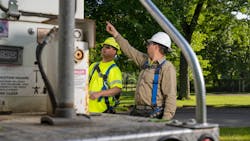S.T.A.R. (Stop, Think, Ask/Act, Review) is a powerful tool that we can apply in any situation — personal or professional — to reduce the chances of being involved in an incident.
As an arborist, stopping is one of the first things we do upon arrival. When we arrive at a job site, it’s important to STOP and conduct a simple assessment that includes looking from a distance, noticing any dead limbs, or anything else obvious.
Additionally, from a safety standpoint, we check all our gear before starting. As arborists, it’s important to conduct checks every day and every time we climb. It’s as simple as making sure our carabiners close properly.
Once an initial assessment is completed, it’s time to THINK and plan our process out. There’s a lot that goes into completing a job – whether a tree is being cut down, removed, or simple limb removal. There’s an art to tree removal, especially when there are things underneath the trees.
When acting, we put our plan into play. Hopefully, everything goes accordingly in a timely manner and as safely as possible, but that’s not always the case. It’s important to ACT safe by not one-handing chainsaws, wearing our chaps, wearing our hard hats and safety glasses, hearing protection, and acting properly. Just because someone isn’t watching doesn’t mean you can skip out on safety measures such as opting out of wearing your chaps.
Equally important is being comfortable making an ASK. Being in a male-dominated industry, it’s easy to have a lot of pride. A lot of us tend not to ask because we’re confident in our decisions, but it’s ok to trust others and ask for a second opinion. Ask yourself questions two times. Ask your co-worker, “Hey, is there something you see that I don’t?” Many of us are at different levels and have different perspectives — nobody looks at one thing the same – we’re all different.
As an arborist, I’m willing to admit I’ve made mistakes on cuts. Even if things go great, I still go through and REVIEW my cuts. Did I cut the hinge too deep on this side? How was my holding wood? I can review how things truly went by looking at my cuts. Maybe something did go wrong. Maybe my roper (the person holding my rope) put too much tension and we guessed the weight. Instead, we can take the time to pull out our phones and calculate a safer estimate.
What’s your why?
A lot of what I’ve mentioned is required in the ANSI Z133 Safety Standard — the basic safety stuff. The reason why S.T.A.R. is important is that these rules are written in blood. These rules weren’t drafted by a person sitting behind a desk because they feel it’s the guidance we need, it’s because someone has cut their arm off, had a tree fall on them, had a stump grinder rip wires out and take their leg off, and so on. Many of these rules have been implemented because someone got hurt and not always in the best way, like a scraped knee. People have lost friends, family members, and loved ones. There’s proof.
This isn’t a guessing game – it’s important to stop and think about things. Ask yourself why you are here today, rather than why you are cutting this tree down. Whether you’re here to earn an income, support your family, love arboriculture, or something else, we all have a why. For me, it’s my daughter. Every time I go into a tree or teach a course, I stress safety to the max because I have a daughter at home. For those of us who have kids, chances are we’ll always say our reason is our children.
That being said, make it a habit to perform a quick self-check before beginning any job or task to reduce errors and make it back home safely to your why. Conducting self-checks with the S.T.A.R is a simple, but crucial part of any human performance improvement initiative. The next time you prepare to begin a task, Stop, Think, Ask/Act, and Review – it might make all the difference.
Bryan Welborn is a traveling crew trainer with ACRT Arborist Training and has more than five years of industry experience. He is an International Society of Arboriculture (ISA) Certified Arborist and certified in ACRT Arborist Training’s Basic Arborist, Advanced Arborist, and Line Clearance Arborist courses. Welborn also holds a Class A Commercial Driver’s License (CDL).
About the Author
Bryan Welborn
Bryan Welborn is a traveling crew trainer with ACRT Arborist Training and has more than five years of industry experience. He is an International Society of Arboriculture (ISA) Certified Arborist and certified in ACRT Arborist Training’s Basic Arborist, Advanced Arborist, and Line Clearance Arborist courses. Welborn also holds a Class A Commercial Driver’s License (CDL).
